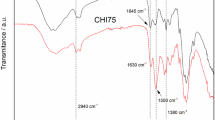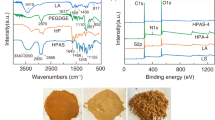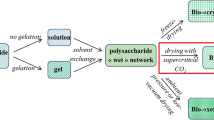Abstract
Chitosan chains (CTS) were grafted onto polyvinyl alcohol fibers (PVAf) with the aid of coupling agent γ-glycidoxypropyltrimethoxysilane, producing grafted fibers PVAf-g-CTS. Then, chloroacetic acid (CA) was used to react with the chitosan chains on the PVAf-g-CTS surface via nucleophilic substitution reaction to produce fibrous PVAf-g-CACTS with multiple adsorption sites. The products were characterized by using FTIR, SEM, XRD and XPS, revealing that the reaction followed the S N 2 mechanism. Optimum parameters, including a reaction temperature of 50 °C and a mass ratio of PVAf-g-CTS to CA of 1:0.12, were determined for the reaction. Adsorption experiments confirmed that PVAf-g-CACTS showed greater adsorption characteristics for Cd(II) in aqueous solutions compared with PVAf-g-CTS and PVAf. In particular, the rate of Cd(II) uptake by using PVAf-g-CACTS was higher, and the equilibrium was reached within 80 min. When pH was 7, the saturated adsorption capacity reached 47.65 mg g−1. The adsorption kinetics conformed to the pseudo-second-order model, and the adsorption process was in accordance with the Langmuir and Temkin isotherm model. Adsorption–desorption cycle experiments showed that PVAf-g-CACTS had good performance of reuse, and the adsorption mechanism was analyzed further by using XPS.















Similar content being viewed by others
References
Tang H, Zhou WJ, Lu A, Zhang LN (2014) Characterization of new sorbent constructed from Fe3O4/chitin magnetic beads for the dynamic adsorption of Cd2+ ions. J Mater Sci 49:123–133. doi:10.1007/s10853-013-7684-z
Najafabadi HH, Irani M, Rad LR, Haratameh AH, Haririan I (2015) Removal of Cu2+, Pb2+ and Cr6+ from aqueous solutions using a chitosan/graphene oxide composite nanofibrous adsorbent. RSC Adv 5:16532–16539
Matlock MM, Howerton BS, Atwood DA (2002) Chemical precipitation of heavy metals from acid mine drainage. Water Res 36:4757–4764
Liu BJ, Wang DF, Xu Y, Huang GQ (2011) Adsorption properties of Cd(II)-imprinted chitosan resin. J Mater Sci 46:1535–1541. doi:10.1007/s10853-010-4958-6
Santhosh C, Velmurugan V, Jacob G, Soon KJ, Andrews NG, Amit B (2016) Role of nanomaterials in water treatment application: a review. Chem Eng J 306:1116–1137
Gedam AH, Dongre RS (2015) Adsorption characterization of Pb(II) ions onto iodate doped chitosan composite: equilibrium and kinetic studies. RSC Adv 5:54188–54201
Hota G, Kumar BR, Ramakrishna WJNS (2008) Fabrication and characterization of a boehmite nanoparticle impregnated electrospun fiber membrane for removal of metal ions. J Mater Sci 43:212–217. doi:10.1007/s10853-007-2142-4
Gedam AH, Dongre RS (2015) Adsorption characterization of Pb(II) ions onto iodate doped chitosan composite: equilibrium and kinetic studies. RSC Adv 5:54188–54201
Muzzarelli RAA (2011) Chitosan composites with inorganics, morphogenetic proteins and stem cells, for bone regeneration. Carbohydr Polym 83:54–63
Verma AK, Dash RR, Bhunia P (2012) A review on chemical coagulation/flocculation technologies for removal of colour from textile wastewaters. J Environ Manag 93:154–168
Ngah WSW, Teong LC, Hanafiah MAKM (2011) Adsorption of dyes and heavy metal ions by chitosan composites: a review. Carbohydr Polym 83:1446–1456
Ciechanowska A, Hanuza J, Stanislawska E, Kociolek-Balawejder E (2015) Synthesis of polymer-based hybrid materials via Mn(II) oxidation with N-bromosulphonamide polymer and their characterization. J Mater Sci 50:4300–4311. doi:10.1007/s10853-015-8982-4
Petit C, Bandosz TJ (2012) Exploring the coordination chemistry of MOF-graphite oxide composites and their applications as adsorbents. Dalton Trans 41:4027–4035
Meng J, Cui JL, Luo DM, Xie MN (2016) Catalytic properties of N-hydroxyphthalimide immobilized on a novel porous organic polymer in the oxidation of toluene by molecular oxygen. RSC Adv 6:68170–68177
Soldatov VS (2008) Syntheses and the main properties of FIBAN fibrous ion exchangers. Solv Extr Ion Exch 26:457–513
Bagheri B, Abdouss M, Aslzadeh MM, Shoushtari AM (2010) Efficient removal of Cr3+, Pb2+ and Hg2+ ions from industrial effluents by hydrolyzed/thioamidated polyacrylonitrile fibres. Iran Polym J 19:911–925
Millon LE, Wan WK (2006) The polyvinyl alcohol-bacterial cellulose system as a new nanocomposite for biomedical applications. J Biomed Mater Res B 79B:245–253
Yuki S, Kanji T, Satoshi H, Akiyoshi O, Maria AL, José DS, Maria AC, Maria HF (2009) Physical, chemical and in vitro biological profile of chitosan hybrid membrane as a function of organosiloxane concentration. Acta Biomater 5:346–355
Divya C, Meha J, Nalini S (2012) Removal of cadmium and hexavalent chromium from electroplating waste water using thiocarbamoyl chitosan. Carbohydr Polym 88:670–675
Ran JB, Hu JX, Sun GL, Chen S, Jiang P (2016) A novel chitosan-tussah silk fibroin/nano-hydroxyapatite compositebone scaffold platform with tunable mechanical strength in a widerange. Int J Biol Macromol 93:87–97
Caldwell JR, Moyer HV (1935) Determination of chloride-A modification of the Volhardmethod. Ind Eng Chem 7:38–39
Gao BJ, Zhang LQ, Chen T (2015) TEMPO immobilized on polymer microspheres-catalyzed oxidation of cyclohexanol by molecular oxygen. Chin J Catal 36:1230–1236
Li ML, Zhang ZQ, Li RH, Wang JJ, li AA (2016) Removal of Pb(II) and Cd(II) ions from aqueous solution by thiosemicarbazide modified chitosan. Int J Biol Macromol 86:876–884
Wang Q, Feng J, Ma LR, Wei W, Xie JM, Xia CK, Zhu JJ, Jiang DL (2016) Synthesis, characterization, and adsorption properties of silica aerogels crosslinked with diisocyanate under ambient drying. J Mater Sci 51:9472–9483. doi:10.1007/s10853-016-0191-2
Miyaji F, Masuda S, Suyama Y (2010) Adsorption removal of lead and cadmium ions from aqueous solution with coal fly ash-derived zeolite/sepiolite composite. J Ceram Soc Jpn 118:1062–1066
Badruddozaa AZM, Shawona ZBZ, Tay TWD, Hidajat K, Uddin MS (2013) Fe3O4/cyclodextrin polymer nanocomposites for selective heavy metals removal from industrial wastewater. Carbohydr Polym 91:322–332
Deng JH, Zhang XR, Zeng GM, Gong JL, Niu QY, Liang J (2013) Simultaneous removal of Cd(II) and ionic dyes from aqueous solution using magnetic graphene oxide nanocomposite as an adsorbent. Chem Eng J 226:189–200
Masoumi A, Ghaemy M (2014) Removal of metal ions from water using nanohydrogel tragacanth gum-g-polyamidoxime: isotherm and kinetic study. Carbohydr Polym 108:206–215
Trakulsujaritchok T, Noiphom N, Tangtreamjitmun N, Saeeng R (2011) Adsorptive features of poly (glycidyl methacrylate-co-hydroxyethyl methacrylate): effect of porogen formulation on heavy metal ion adsorption. J Mater Sci 46:5350–5362. doi:10.1007/s10853-011-5473-0
Li XL, Qi YX, Li YF (2013) Novel magnetic beads based on sodium alginate gel crosslinked by zirconium(IV) and their effective removal for Pb2+ in aqueous solutions by using a batch and continuous systems. Bioresour Technol 142:611–619
Bai L, Hu H, Fu W, Wan J, Cheng X, Zhu LG (2011) Synthesis of a novel silica-supported dithiocarbamate adsorbent and its properties for the removal of heavy metal ions. J Hazard Mater 195:261–275
Luo C, Wei RY, Guo D, Zhang SF, Yan SQ (2013) Adsorption behavior of MnO2 functionalized multi-walled carbon nanotubes for the removal of cadmium from aqueous solutions. Chem Eng J 225:406–415
Nassar NN (2011) Kinetics, equilibrium and thermodynamic studies on the adsorptive removal of nickel, cadmium and cobalt from wastewater by superparamagnetic iron oxide nanoadsorbents. Can J Chem Eng 90:1231–1238
Chauque EFC, Dlamini LN, Adelodun AA, Greyling CJ, Ngila JC (2016) Modification of electrospun polyacrylonitrile nanofibers with EDTA for the removal of Cd and Cr ions from water effluents. Appl Surf Sci 369:19–28
Chu L, Liu C, Zhou G (2015) A double network gel as low cost and easy recycle adsorbent: highly efficient removal of Cd(II) and Pb(II) pollutants from wastewater. J Hazard Mater 300:153–160
Acknowledgements
This work was partly supported by Zhejiang Provincial Textiles Technology Collaborative Innovation Center (2011 Collaborative Innovation Center) organized by Zhejiang Sci-Tech University (ZSTU). Dr. Peng Chen would like to acknowledge supports from 330 Overseas Talent Program (No. ACX201424) of Keqiao district, Shaoxing and Youth Innovation Promotion Association, CAS.
Author information
Authors and Affiliations
Corresponding author
Rights and permissions
About this article
Cite this article
Meng, J., Cui, J., Yu, J. et al. Preparation of green chelating fibers and adsorption properties for Cd(II) in aqueous solution. J Mater Sci 53, 2277–2289 (2018). https://doi.org/10.1007/s10853-017-1653-x
Received:
Accepted:
Published:
Issue Date:
DOI: https://doi.org/10.1007/s10853-017-1653-x




